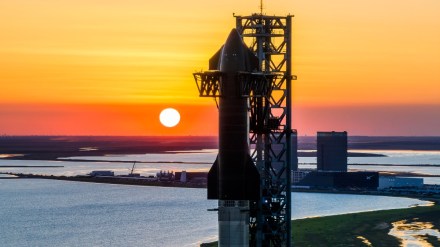SpaceX launched its colossal Starship rocket system from its Boca Chica, Texas, facility, marking a significant milestone in space exploration. The launch of the 400-foot-tall (122-meter-tall) rocket system aimed to demonstrate the ship’s ability to ferry astronauts to the Moon and Mars. However, an unexpected setback during the booster recovery overshadowed the mission’s triumphs, reports Reuters.
Super Heavy Booster’s Fiery Ending
The Super Heavy booster, a 233-foot-tall (71-meter-tall) first stage designed for reusability, separated from the Starship second stage at an altitude of 40 miles (62 kilometres). Instead of executing a planned catch-landing on mechanical arms attached to the launch tower, the booster splashed down in the Gulf of Mexico, where it exploded into a massive fireball. This unexpected outcome highlighted challenges in SpaceX’s ambitious reusable rocket program.
The booster’s failed recovery contrasts with a successful demonstration of the catch-landing technique last month, which Elon Musk had hailed as a significant advancement. Ahead of the launch, Musk described Tuesday’s test as “faster/harder” on social media, emphasising the experimental nature of the mission.
Starship’s Successes in Space
While the booster’s recovery faltered, the Starship upper stage achieved critical milestones. It completed a flight around Earth and performed a successful daytime splashdown in the Indian Ocean roughly an hour later. Notably, Starship reignited its space-tailored engine during flight, demonstrating manoeuvrability in space—an objective SpaceX had struggled with in previous missions.
NASA Administrator Bill Nelson praised the achievement on social media, calling the in-space engine reignition a “major step forward.”
Trump’s Presence and Deepening Alliance with Musk
Former US President-elect Donald Trump attended the launch, signalling growing collaboration with Musk. A vocal supporter of SpaceX and Tesla, Trump has backed Musk’s ventures and appointed him co-leader of a government efficiency initiative aimed at reducing regulatory hurdles.
Trump, who previously lauded Starship’s engineering feats, expressed admiration for the rocket’s design. His presence at the launch underscores his administration’s focus on advancing space exploration, particularly the ambitious goal of landing humans on Mars—a vision closely aligned with Musk’s aspirations.
Regulatory Challenges and Progress
SpaceX’s swift regulatory approval for Tuesday’s launch, granted by the US Federal Aviation Administration (FAA), demonstrated the agency’s evolving approach to accommodating the growing commercial space industry. The expedited approval process came just over a month after Starship’s last flight, signalling progress in regulatory efficiency—a long-standing point of contention for Musk.
Looking Ahead: Starship’s Role in Space Exploration
Despite the booster’s setback, SpaceX remains optimistic about the future of Starship. Musk highlighted the numerous design improvements tested during the flight and reiterated SpaceX’s goal of achieving 400 Starship launches in the next four years, matching the pace of its workhorse Falcon rockets.
Under a potential second Trump administration, Musk’s vision of a Mars-bound future could gain further momentum. SpaceX’s partnership with NASA through the Artemis program is expected to evolve, potentially shifting focus toward interplanetary travel.
Tuesday’s launch demonstrated both the promise and challenges of SpaceX’s Starship program. While setbacks like the booster’s fiery end remind us of the risks involved in pushing technological boundaries, the mission’s achievements underscore the incredible strides SpaceX continues to make in advancing humanity’s reach into space.
With Musk at the helm and government support growing, the path to Mars seems more attainable than ever. However, as the Starship program progresses, overcoming technical and regulatory hurdles will remain crucial to realizing its ambitious goals.
